Formentera is the smallest inhabited island of Spain’s Balearic Archipelago in the western Mediterranean, with a total surface of 83.2 km² and a highest point of 192 m. Formentera lies seven kilometres off the southern tip of Ibiza (Eivissa in Catalan), separated by a shallow strait containing several small islands. During the last Ice Age the strait was a land bridge connecting Formentera, Ibiza and the small islands, forming a single landmass.
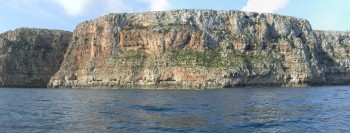
La Mola de Formentera with Punta des Garrovet and Punta de la Xindria
The horizontal stratification of the limestone sea-cliff outcrops with hundreds of caves and crevices makes a habitat for the cave-breeding Balearic Shearwater

A Balearic Shearwater at its breeding site, photograph by Daniel Oro
The resident human population of Formentera is just over 10 000, although Ibiza and Formentera together received over 2.7 million tourists in 2014. Formentera is a popular one-day destination for tourists that stay in Ibiza. It also has its own tourist network of hotels and holiday resorts, some of them very near to seabird breeding sites.
The population of the ACAP-listed and Critically Endangered Balearic Shearwater Puffinus mauretanicus on Formentera and islands in the strait was estimated in 2003 as 692 pairs. There are three colonies on the island of Formentera itself: la Mola (460 pairs), Cap Barbaria (110 pairs) and Punta Prima (50 pairs). The shearwaters also breed on the nearby small islands of Espalmador (32 pairs) and Espardell (40 pairs). Scopoli’s Shearwaters Calonectris diomedea, Mediterranean Cormorants Phalacrocorax aristotelis desmarestii and Yellow-legged Gulls Larus michahellis also breed on the sea cliffs of Formentera and on the neighbouring islands.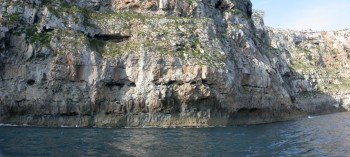
Coves de l’Arena at la Mola
A quaternary sand dune covers the floor of the caves providing soft material for breeding
The Balearic Shearwater is the most abundant bird species found in archaeological sites on Formentara. Subfossil shearwater remains can be found in nearly every cave or crevice along the island’s limestone coastline, and there is archaeological evidence from several sites that they were an important food source for the first human settlers, with exploitation continuing right up until the 1990s. Early shearwater sites were easily accessible and likely both young and adult birds were taken, but as populations dwindled and birds became largely restricted to the most inaccessible ledges of the massive sea cliffs of la Mola and Cap Barbaria, only adult birds were captured as they entered the small caves and crevices along the ledges.
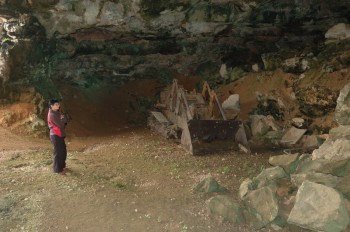
Large caves near cliff tops are easily accessible. A project to build a “disco-restaurant” in this cave was abandoned, leaving behind the bulldozer. Balearic Shearwater bones litter the floor

Shearwater bones and Black Rat and feral cat footprints are common in all the large accessible caves in the sea cliffs of Formentera
Collecting Balearic Shearwaters was a dangerous activity, dangling down cliffs with woven ropes made of grass, and was limited to a few experienced families. Bird carcasses were often exchanged for food and other household foods: the lighthouse keeper of la Mola used to exchange paraffin petroleum for shearwaters.
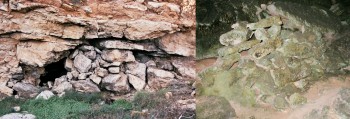
Stone walls were built to trap adult shearwaters by blocking up most of the entrance of inaccessible caves and crevices
Nooses were then used to snare birds

Site of Balearic Shearwater colony on Espalmador, Natural Park of Ses Salines, off the north coast of Formentera
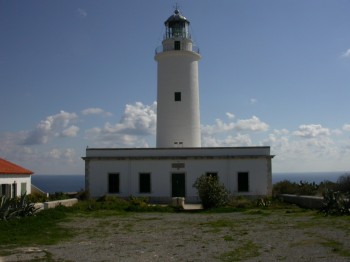
La Mola Lighthouse, a perfect place to listen to Balearic Shearwaters at night
A “virotador “ (virot is the local Catalan name for a shearwater) helped discover the last breeding sites of the Balearic Shearwater on Formentera, but field work was discontinued and there is little current information on the island’s breeding population.
Exploitation of seabirds and the introduction of invasive predators such as Domestic Cats Felis catus (which turned feral) and Black Rats Rattus rattus have caused a great impact on the seabirds of Formentera. Habitat destruction is an issue in some of the breeding areas, and a problem not yet evaluated is artificial pollution from new tourist facilities.
ACAP Latest News has previously covered the shearwaters of Sa Cella and the Cabrera Archipelago Maritime-Terrestrial National Park on Mallorca and in Menorca in the Balearic Islands.
Selected Literature:
Alcover, J.A. 1989. Les Aus Marines Fóssils de les Pitiüses en el Context de la Mediterrània. In: López-Jurado, C. (Ed.). Palma de Mallorca, Grup Balear d'Ornitologia i Defensa de la Naturalesa. Aves Marinas. Actas de la IV Reunión dek Grupo Ibérico de Aves Marinas, Sant Francesc Xavier de Formentera 29 de Octubre al 1 de Noviembre de 1988. pp. 33-43.
Alcover, J.A., Florit, F., Mourer-Chauviré, C. & Weesie, P.D.M. 1992. The avifaunas of the isolated Mediterranean islands during the Middle and Late Pleistocene. Papers in Avian Paleontology 36: 273-283.
Alcover, J.A., McMinn, M. & Altaba, C.R. 1994. Eivissa: a Pleistocene oceanic-like island in the Mediterranean. National Geographic Research & Exploration 10: 236-238.
Arcos, J.M. 2011. International Species Action Plan for the Balearic Shearwater Puffinus mauretanicus. Madrid: SEO/BirdLIfe & BirdLife International. 51 pp.
García, D. & Arbona, P. 2001. Nueva localidad de nidificación de la Pardela Balear Puffinus mauretanicus en el islote de s'Espalmador. Anuari Ornitològic de les Balears 16: 69-70.
Mayol, J. 1986. Human impact on seabirds in the Balearic Islands. In: Monbailliu, X.G. (Ed.). Mediterranean Marine Avifauna. Population Studies and Conservation. Berlin Heidelberg: Springer-Verlag. pp. 379-408.
Ramis, D., López-Gari, J.M., McMinn, M., Martínez, J.A. & Quintana, J. 2011. Els mamífers i les aus del jaciment arqueològic de la cova des Riuets (Formentera). Eivissa: Consell Insular d'Eivissa. 17 pp.
Ruiz, A. & Martí, R. 2004. La Pardela Balear. Madrid: SEO BirdLife & Conselleria de Medi Ambient del Govern de les Illes Balears. [no.] pp.
Miguel McMinn, Skua Gabinet d'Estudis Ambientals SLP, Mallorca, Spain & John Cooper, ACAP Information Officer, 14 April 2015

 English
English  Français
Français  Español
Español